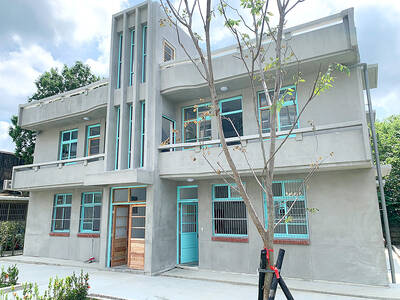This year confirmed that Taiwan is a powerhouse in modern dance, while its ballet talent has been left in the dust. It also confirmed that the 10-year old Novel Hall Dance Series is a crucial forum for dance from around the world.
A key factor is Lin Hwai-min (林懷民), founder of Cloud Gate Dance Theatre (雲門舞集) and artistic director of Novel Hall Dance. Even as he continues to create for his own companies, his eye for talent has enriched Taiwan’s dance scene through the young choreographers he has championed and the troupes he picks to perform at Novel Hall.
Among those choreographers are former Cloud Gate dancer Bulareyaung Pagarlava (布拉瑞揚), whose young company with partner Sheu Fang-yi (許芳宜), LaFa & Artists, delivered another powerful performance in September as part of the Taipei Arts Festival. The highlight of the show was Lament, a beautiful elegy that Bula developed from a piece commissioned by the Martha Graham Center.
The festival also brought a great collaboration between Cloud Gate 2 and the Taipei Chinese Orchestra (台北市立國樂團), the highlight of which was Happiness and Music (樂) by Cloud Gate 2’s resident choreographer Cheng Tsung-lung (鄭宗龍), where dancers played, musicians danced and a whole host of conventional and non-conventional instruments were used. Also on the program was Huang Yi’s (黃翊) delightful TA-TA for Now for five dancers, five chairs and a violinist.
The standout in this year’s Novel Hall Dance program was Briton Wayne McGregor’s Random Dance troupe, which performed his hour-long Entity in May. The 39-year-old McGregor’s choreography is a stunning revelation of the human body’s potential. His dancers curve and twist their whippet-like bodies in angular contortions with such speed and fluidity; by the time the audience’s registers it all, the dancers are already two or three steps ahead. McGregor made it clear why he has been one of the hottest choreographers working for more than a decade.
Another Lin who has had a tremendous impact on Taiwan’s dance world is Lin Lee-chen (林麗珍), whose stunning Song of Pensive Beholding (Chants de la Destinee, 觀) for her Legend Lin Dance Theatre (無垢舞蹈劇場) this month at the National Theater closed out the year for dance. Lin’s productions are lush visual masterpieces whose sensual aesthetics stand in stark contrast to her minimalist choreography.
On a sadder note, 2009 may prove to be the end of Wang Tzer-shing’s (王澤馨) dream of staging world-class galas in Taipei. The 3rd International Ballet Star Gala was a terrific program, bringing new stars, established faces and several new works. The performances were breathtaking. But Wang has said the struggle to pull off such a program is too much for one person to bear, and without government or private-sector support, she won’t do it again. This will be a tremendous loss for both dance fans and students. Young dancers won’t have role models, and balletomanes will be stuck waiting for the next tour of the Mariinksy, or another company, serving up the same old classics.
Despite the best efforts of Wang and other ballet teachers, ballet remains the poor relation in Taiwan’s dance world, and the lack of rigorous daily training and studio time was clearly evident in this year’s local productions.

June 2 to June 8 Taiwan’s woodcutters believe that if they see even one speck of red in their cooked rice, no matter how small, an accident is going to happen. Peng Chin-tian (彭錦田) swears that this has proven to be true at every stop during his decades-long career in the logging industry. Along with mining, timber harvesting was once considered the most dangerous profession in Taiwan. Not only were mishaps common during all stages of processing, it was difficult to transport the injured to get medical treatment. Many died during the arduous journey. Peng recounts some of his accidents in

“Why does Taiwan identity decline?”a group of researchers lead by University of Nevada political scientist Austin Wang (王宏恩) asked in a recent paper. After all, it is not difficult to explain the rise in Taiwanese identity after the early 1990s. But no model predicted its decline during the 2016-2018 period, they say. After testing various alternative explanations, Wang et al argue that the fall-off in Taiwanese identity during that period is related to voter hedging based on the performance of the Democratic Progressive Party (DPP). Since the DPP is perceived as the guardian of Taiwan identity, when it performs well,

A short walk beneath the dense Amazon canopy, the forest abruptly opens up. Fallen logs are rotting, the trees grow sparser and the temperature rises in places sunlight hits the ground. This is what 24 years of severe drought looks like in the world’s largest rainforest. But this patch of degraded forest, about the size of a soccer field, is a scientific experiment. Launched in 2000 by Brazilian and British scientists, Esecaflor — short for “Forest Drought Study Project” in Portuguese — set out to simulate a future in which the changing climate could deplete the Amazon of rainfall. It is

The Taiwan People’s Party (TPP) on May 18 held a rally in Taichung to mark the anniversary of President William Lai’s (賴清德) inauguration on May 20. The title of the rally could be loosely translated to “May 18 recall fraudulent goods” (518退貨ㄌㄨㄚˋ!). Unlike in English, where the terms are the same, “recall” (退貨) in this context refers to product recalls due to damaged, defective or fraudulent merchandise, not the political recalls (罷免) currently dominating the headlines. I attended the rally to determine if the impression was correct that the TPP under party Chairman Huang Kuo-Chang (黃國昌) had little of a